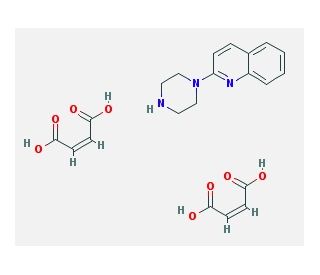

Quipazine dimaleate (CAS 5786-68-5)
See product citations (5)
QUICK LINKS
Quipazine dimaleate is a selective agonist of 5-HT3 receptors (SR-3, HTR3). 5-HT3 receptors (SR-3, HTR3) are neuronal ligand-gated ion channels that produce excitatory responses in neurons when activated by seratonin or other agonists for the receptor. Quipazine dimaleate may act to display anti-depressant and anorectic effects and to promote cellular proliferation. Quipazine maleate (QPM) is a lab-made substance extensively employed in scientific research for many years. Derived from the naturally occurring plant alkaloid quipazine, QPM acts as an agonist for the 5-HT2A receptor. By binding to and stimulating this receptor, it triggers a range of physiological and biochemical responses. QPM finds widespread application in laboratory investigations dedicated to examining the consequences of serotonin receptor activation.
Quipazine dimaleate (CAS 5786-68-5) References
- Direct agonists for serotonin receptors enhance locomotor function in rats that received neural transplants after neonatal spinal transection. | Kim, D., et al. 1999. J Neurosci. 19: 6213-24. PMID: 10407057
- Role of melatonin in the control of growth and growth hormone secretion in poultry. | Zeman, M., et al. 1999. Domest Anim Endocrinol. 17: 199-207. PMID: 10527123
- Local effects of the serotonin agonist quipazine on the suprachiasmatic nucleus of rats. | Kalkowski, A. and Wollnik, F. 1999. Neuroreport. 10: 3241-6. PMID: 10574568
- Effect of quipazine, a selective 5-HT3 agonist, on dietary self-selection of different macronutrient diets in male and female rats. | Mok, E., et al. 2000. Appetite. 34: 313-25. PMID: 10888295
- Reversal of testosterone-induced dominance by the serotonergic agonist quipazine. | Bonson, KR. and Winter, JC. 1992. Pharmacol Biochem Behav. 42: 809-13. PMID: 1513863
- Transducing agonist binding to channel gating involves different interactions in 5-HT3 and GABAC receptors. | Price, KL., et al. 2007. J Biol Chem. 282: 25623-30. PMID: 17606617
- Serotonin receptor agonist quipazine promotes proliferation and apoptosis of human hepatocyte strain of L-02 strain. | Liu, Y. and Zhang, ZY. 2009. Hepatobiliary Pancreat Dis Int. 8: 278-81. PMID: 19502168
- Serotonin-mediated central fatigue underlies increased endurance capacity in mice from lines selectively bred for high voluntary wheel running. | Claghorn, GC., et al. 2016. Physiol Behav. 161: 145-154. PMID: 27106566
- Characterization of [3H]meta-chlorophenylbiguanide binding to 5-HT3 receptors in N1E-115 neuroblastoma cells. | Lummis, SC., et al. 1993. Eur J Pharmacol. 243: 7-11. PMID: 8253126
- Serotonergic agonists and antagonists affect endurance performance in the rat. | Bailey, SP., et al. 1993. Int J Sports Med. 14: 330-3. PMID: 8407063
- Role of alpha1-adrenoceptors in the reduction of external carotid blood flow induced by buspirone and ipsapirone in the dog. | Terrón, JA., et al. 1996. Life Sci. 58: 63-73. PMID: 8628112
- Evidence for serotonin sensitivity of adult rat spinal axons: studies using randomized double pulse stimulation. | Saruhashi, Y., et al. 1997. Neuroscience. 80: 559-66. PMID: 9284357
- Quipazine and light have similar effects on c-fos induction in the rat suprachiasmatic nucleus. | Moyer, RW., et al. 1997. Brain Res. 765: 337-42. PMID: 9313909
- Chronic haloperidol produces a time- and dose-related slowing of lick rhythm in rats: implications for rodent models of tardive dyskinesia and neuroleptic-induced parkinsonism. | Fowler, SC. and Wang, G. 1998. Psychopharmacology (Berl). 137: 50-60. PMID: 9631956
- Attenuation of the lordosis-inhibiting effects of 8-OH-DPAT by TFMPP and quipazine. | Wolf, A., et al. 1998. Brain Res. 804: 206-11. PMID: 9757039
Ordering Information
| Product Name | Catalog # | UNIT | Price | Qty | FAVORITES | |
Quipazine dimaleate, 100 mg | sc-201145 | 100 mg | $143.00 |
